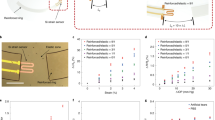Abstract
We constructed a contact lens with an integrated pressure-sensing device. It is housed in a container with three force-sensing elements, each 120° apart, enabling measurement of the appositional force, i.e., the force with which the instrument is held against the eye. In part 1 of the study, the lens' precision was tested against a manometric transducer in five eye bank eyes. The second part examined pressure as a factor dependent on the appositional force, and the third part of the study investigated the correct procedure for measuring baseline eye pressure, p0.
The instrument described here allows investigation of three examination parameters: (a) the measurement of p0, the pressure independent of the appositional force; (b) the continuous measurement of the intraocular pressure (IOP); (c) the measurement of the IOP dependent on the appositional force, including artificial IOP elevation.
Similar content being viewed by others
References
Maklakoff C. L’ophtalmomérie. Arch Ophthalmol (Paris) 1885; 5: 159¶ 165.
Maurice DM. An applanation tonometer of new principle. Brit J Ophthal 1951; 35: 178¶ 182.
Goldmann H, Schmidt T. Ñber Applanationstonometrie. Ophthalmologica 1957; 34: 221¶ 242.
Mackay RS, Marg E. Fast, automatic, electronic tonometers based on an exact theory. Acta Ophthalmologica 1959; 37: 495¶ 507.
Entenmann B, Robert Y, Pirani P, Kanngiesser H, Dekker P. Contact lens tonometry ¶application in humans. Invest Ophthalmol Vis Sci. 1997; 38: 2447¶ 2451.
Collins R, van der Werif TJ. Mathematical models of the dynamics of the human eye. In: Levin S (ed) Lecture Notes in Biomathematics. New York: Springer, 1980: Vol 34(2¶ 3).
Dreyer M. Kapillarer Flüssigkeitsanstieg zwischen parallelen Platten unter kompensierter Gravitation. Fortschr. Ber. Düsseldorf: VDI-Verlag, 1994: VDI Reihe 7 Nr 24.
Tiffany JM. Viscoelastic properties of human tears and polymer solutions. In: Sullivan DA (ed) Lacrimal Gland, Tear Film, and Dry Eye Syndromes. New York: Plenum Press, 1994: 267¶ 270.
Miller D. Measurement of the surface tension of tears. Arch Ophthalmol 1969; 82: 368¶ 371.
Mishima S. Some physiological aspects of the precorneal tear film. Arch Ophthalmol 1965; 73: 233¶ 241.
Imbert A. Théorie des ophtalmotonomè tres. Arch Ophthalmol Paris. 1885; 5: 358¶ 363.
Fick A. Ñber die Messung des Druckes im Auge. Pflügers Arch 1888; 42: 86¶ 100.
Rights and permissions
About this article
Cite this article
Dekker, P.W., Robert, Y.C.A., Kanngiesser, H. et al. Principles of contact lens tonometry. Int Ophthalmol 22, 105–111 (1998). https://doi.org/10.1023/A:1006292102204
Issue Date:
DOI: https://doi.org/10.1023/A:1006292102204




